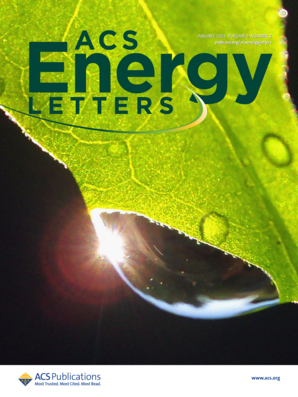利用溶剂间协同效应构建全天候混合动力钠离子/金属电池
IF 19.3
1区 材料科学
Q1 CHEMISTRY, PHYSICAL
引用次数: 0
摘要
在极端条件下,可充电钠离子电池(SIBs)仍然受到Na+传输/脱溶动力学缓慢和电极/电解质界面不稳定的限制,从而导致容量衰减快,寿命短。本文提出了利用亚硫酸二甲酯(DMS)和戊二腈(GN)溶剂之间的溶剂-溶剂氢键相互作用来制备广温sib的电解质工程。DMS和GN溶剂之间形成的氢键不仅增强了DMS的抗氧化能力,同时通过使DMS远离Na+离子,促进了松散溶剂化结构的形成,有利于Na+的迁移/脱溶动力学。设计好的电解质在- 55 ~ 60°C的NaNi0.33Fe0.33Mn0.33O2 ||Na半电池中具有广泛的应用温度,同时在- 40 ~ 45°C的预活化硬质碳阳极下也获得了更好的循环稳定性。本研究揭示了溶剂间协同效应在宽温度电解质设计中的作用,专门用于调节电解质的热力学和动力学行为。本文章由计算机程序翻译,如有差异,请以英文原文为准。

Constructing All-Climate Hybrid Sodium Ion/Metal Batteries through Intersolvent Synergistic Effect
Rechargeable sodium ion batteries (SIBs) under extreme conditions are still limited by sluggish Na+ transport/desolvation kinetics and unstable electrode/electrolyte interface, thus leading to rapid capacity decay and a short lifespan. Herein, electrolyte engineering is proposed via solvent–solvent hydrogen bonding interaction between dimethyl sulfite (DMS) and glutaronitrile (GN) solvents for wide-temperature SIBs. The formed hydrogen bonding between DMS and GN solvents not only enhances the antioxidative ability of DMS but also simultaneously promotes the formation of a loose solvation structure by distancing DMS from Na+ ions, facilitating Na+ transport/desolvation kinetics. The well-designed electrolyte exhibits wide-temperature application from −55 to 60 °C in NaNi0.33Fe0.33Mn0.33O2 ||Na half cells, while the improved cycling stability with preactivated hard carbon anode is also obtained from −40 to 45 °C. This work sheds light on intersolvent synergistic effect for wide-temperature electrolyte design, specializing in regulating electrolyte thermodynamic and kinetic behavior.
求助全文
通过发布文献求助,成功后即可免费获取论文全文。
去求助
来源期刊

ACS Energy Letters
Energy-Renewable Energy, Sustainability and the Environment
CiteScore
31.20
自引率
5.00%
发文量
469
审稿时长
1 months
期刊介绍:
ACS Energy Letters is a monthly journal that publishes papers reporting new scientific advances in energy research. The journal focuses on topics that are of interest to scientists working in the fundamental and applied sciences. Rapid publication is a central criterion for acceptance, and the journal is known for its quick publication times, with an average of 4-6 weeks from submission to web publication in As Soon As Publishable format.
ACS Energy Letters is ranked as the number one journal in the Web of Science Electrochemistry category. It also ranks within the top 10 journals for Physical Chemistry, Energy & Fuels, and Nanoscience & Nanotechnology.
The journal offers several types of articles, including Letters, Energy Express, Perspectives, Reviews, Editorials, Viewpoints and Energy Focus. Additionally, authors have the option to submit videos that summarize or support the information presented in a Perspective or Review article, which can be highlighted on the journal's website. ACS Energy Letters is abstracted and indexed in Chemical Abstracts Service/SciFinder, EBSCO-summon, PubMed, Web of Science, Scopus and Portico.
 求助内容:
求助内容: 应助结果提醒方式:
应助结果提醒方式:


